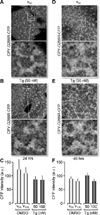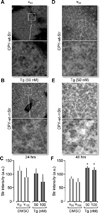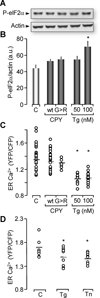Luminal Ca2+ depletion during the unfolded protein response in Xenopus oocytes: cause and consequence
- PMID: 23415071
- PMCID: PMC3594557
- DOI: 10.1016/j.ceca.2013.01.002
Luminal Ca2+ depletion during the unfolded protein response in Xenopus oocytes: cause and consequence
Abstract
The endoplasmic reticulum (ER) is a Ca(2+) storing organelle that plays a critical role in the synthesis, folding and post-translational modifications of many proteins. The ER enters into a condition of stress when the load of newly synthesized proteins exceeds its folding and processing capacity. This activates a signal transduction pathway called the unfolded protein response (UPR) that attempts to restore homeostasis. The precise role of ER Ca(2+) in the initiation of the UPR has not been defined. Specifically, it has not been established whether ER Ca(2+) dysregulation is a cause or consequence of ER stress. Here, we report that partial depletion of ER Ca(2+) stores induces a significant induction of the UPR, and leads to the retention of a normally secreted protein Carboxypeptidase Y. Moreover, inhibition of protein glycosylation by tunicamycin rapidly induced an ER Ca(2+) leak into the cytosol. However, blockade of the translocon with emetine inhibited the tunicamycin-induced Ca(2+) release. Furthermore, emetine treatment blocked elF2α phosphorylation and reduced expression of the chaperone BiP. These findings suggest that Ca(2+) may be both a cause and a consequence of ER protein misfolding. Thus, it appears that ER Ca(2+) leak is a significant co-factor for the initiation of the UPR.
Copyright © 2013 Elsevier Ltd. All rights reserved.
Figures







Similar articles
-
Calcineurin interacts with PERK and dephosphorylates calnexin to relieve ER stress in mammals and frogs.PLoS One. 2010 Aug 5;5(8):e11925. doi: 10.1371/journal.pone.0011925. PLoS One. 2010. PMID: 20700529 Free PMC article.
-
Pharmacological inhibition of translocon is sufficient to alleviate endoplasmic reticulum stress and improve Ca2+ handling and contractile recovery of stunned myocardium.Eur J Pharmacol. 2022 Jan 5;914:174665. doi: 10.1016/j.ejphar.2021.174665. Epub 2021 Nov 30. Eur J Pharmacol. 2022. PMID: 34861208
-
Modulation of ER stress and apoptosis by endoplasmic reticulum calcium leak via translocon during unfolded protein response: involvement of GRP78.FASEB J. 2013 Apr;27(4):1600-9. doi: 10.1096/fj.12-218875. Epub 2013 Jan 15. FASEB J. 2013. PMID: 23322163
-
Regulation of calcium homeostasis and flux between the endoplasmic reticulum and the cytosol.J Biol Chem. 2022 Jul;298(7):102061. doi: 10.1016/j.jbc.2022.102061. Epub 2022 May 21. J Biol Chem. 2022. PMID: 35609712 Free PMC article. Review.
-
Endoplasmic Reticulum Stress Signaling and Neuronal Cell Death.Int J Mol Sci. 2022 Dec 2;23(23):15186. doi: 10.3390/ijms232315186. Int J Mol Sci. 2022. PMID: 36499512 Free PMC article. Review.
Cited by
-
Gradual ER calcium depletion induces a progressive and reversible UPR signaling.PNAS Nexus. 2024 Jun 12;3(6):pgae229. doi: 10.1093/pnasnexus/pgae229. eCollection 2024 Jun. PNAS Nexus. 2024. PMID: 38933930 Free PMC article.
-
Calcineurin β protects brain after injury by activating the unfolded protein response.Neurobiol Dis. 2016 Oct;94:139-56. doi: 10.1016/j.nbd.2016.06.011. Epub 2016 Jun 19. Neurobiol Dis. 2016. PMID: 27334877 Free PMC article.
-
Endoplasmic reticulum stress is the crossroads of autophagy, inflammation, and apoptosis signaling pathways and participates in liver fibrosis.Inflamm Res. 2015 Jan;64(1):1-7. doi: 10.1007/s00011-014-0772-y. Epub 2014 Oct 7. Inflamm Res. 2015. PMID: 25286903 Review.
-
Age-related cataracts: Role of unfolded protein response, Ca2+ mobilization, epigenetic DNA modifications, and loss of Nrf2/Keap1 dependent cytoprotection.Prog Retin Eye Res. 2017 Sep;60:1-19. doi: 10.1016/j.preteyeres.2017.08.003. Epub 2017 Aug 31. Prog Retin Eye Res. 2017. PMID: 28864287 Free PMC article. Review.
-
Endoplasmic reticulum stress-induced hepatic stellate cell apoptosis through calcium-mediated JNK/P38 MAPK and Calpain/Caspase-12 pathways.Mol Cell Biochem. 2014 Sep;394(1-2):1-12. doi: 10.1007/s11010-014-2073-8. Epub 2014 Jun 25. Mol Cell Biochem. 2014. PMID: 24961950
References
-
- Alberts BJ, Lewis A, Raff J, Robberts M, Walter, P K. Garland Science. New York, NY: 2002. Molecular Biology of the Cell.
-
- Hammond C, Helenius A. Quality control in the secretory pathway. Curr Opin Cell Biol. 1995;7:523–529. - PubMed
-
- Berridge MJ. The endoplasmic reticulum: a multifunctional signaling organelle. Cell Calcium. 2002;32:235–249. - PubMed
-
- Meldolesi J, Pozzan T. The endoplasmic reticulum Ca2+ store: a view from the lumen. Trends Biochem Sci. 1998;23:10–14. - PubMed
Publication types
MeSH terms
Substances
Grants and funding
LinkOut - more resources
Full Text Sources
Other Literature Sources
Miscellaneous

